
Commercial Pulse Report
A bi-weekly update on small business health.
The bi-weekly Commercial Pulse provides a directional update on small business credit. It delivers a quick read on current market impacts, high level credit trends, score and attribute impacts, and other market related activities.

Experian Commercial Pulse Report Explores Implications of Rising Premiums As the year draws to a close, one issue looms large for millions of small business owners: the rising cost of healthcare. According to the latest Experian Commercial Pulse Report, small business survival may soon hinge on a single factor — whether enhanced Affordable Care Act (ACA) subsidies are extended into 2026. Watch the Commercial Pulse Update The Clock Is Ticking on ACA Subsidies The American Rescue Plan and Inflation Reduction Act temporarily expanded ACA subsidies, helping make coverage more affordable for millions. But those enhancements are set to expire at the end of 2025 — a policy shift that could unleash a wave of economic strain. The Kaiser Family Foundation estimates that if these subsidies lapse, individuals who purchase insurance through the ACA marketplace could see a 75% increase in premiums. Why does this matter so much for small businesses? Because half of all ACA marketplace enrollees are small business owners, entrepreneurs, or their employees. Coverage Is Shrinking, and Costs Keep Climbing Smaller businesses have historically been less likely to offer health insurance benefits than their larger counterparts. In 2025, only 64% of businesses with 25 to 49 employees offer health benefits — the lowest level ever recorded. And while large employers are still required by the ACA to offer coverage to full-time workers, they too are feeling the pressure. Since 2010, employers have gradually reduced the share of healthcare premiums they cover, even as deductibles have risen by 164% for single coverage plans. The result? Business owners are being squeezed from both sides — by rising insurance costs and a more financially stressed workforce. The Ripple Effects Could Be Widespread If enhanced subsidies aren’t renewed, many small businesses may have no choice but to: Shut down operations Cut staff Shift jobs into larger organizations that can offer coverage That would be a blow not only to small business dynamism but also to broader economic sectors. Reduced consumer spending could hit industries like retail, real estate, and manufacturing, while healthcare providers face payment cuts and job losses due to shrinking coverage pools. What’s Next? With Congress set to vote on subsidy extensions before the end of the year, the stakes couldn’t be higher. The outcome will likely define affordability, access, and entrepreneurship for years to come. For small business owners, now is the time to assess your coverage plans, understand your employee needs, and prepare for potential cost increases. For policymakers and industry leaders, it’s a critical moment to ensure healthcare reforms continue to support the backbone of the U.S. economy — small businesses. Experian continues to provide actionable data to help businesses, lenders, and policymakers navigate uncertainty. To access the full Commercial Pulse Report and explore more insights on small business credit and sector-specific performance: ✔ Visit our Commercial Insights Hub for in-depth reports and expert analysis. ✔ Subscribe to our YouTube channel for regular updates on small business trends. ✔ Connect with your Experian account team to explore how data-driven insights can help your business grow. Download the Commercial Pulse Report Visit Commercial Insights Hub Related Posts
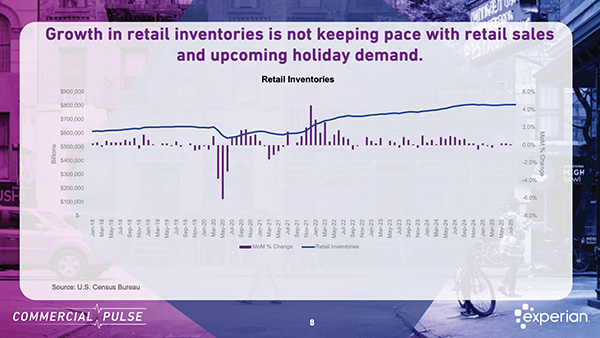
Explore retail industry risk trends for Q4 2025 inventory gaps and credit shifts impact CRO strategies in the latest Commercial Pulse Report.
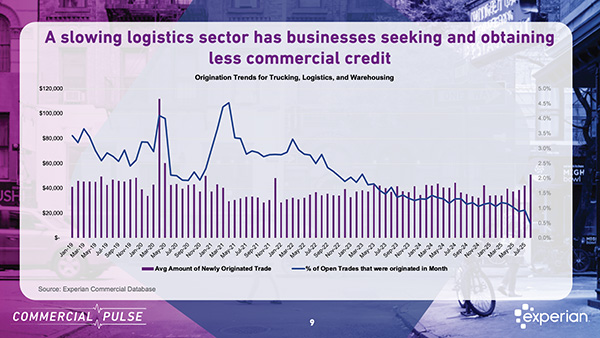
Logistics credit risk is rising according to Experian's latest Commercial Pulse report, signaling financial strain.
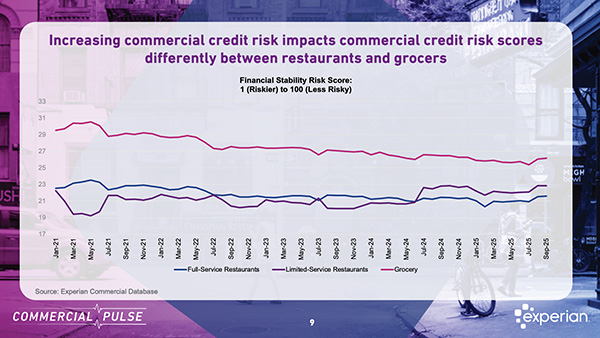
Rising costs are continuing to squeeze American wallets — and perhaps nowhere is that more apparent than in the food sector. According to the latest Experian Commercial Pulse Report (October 14, 2025), food prices are having a profound impact on where and how consumers choose to eat. With the Consumer Price Index for food rising 3.2% year-over-year, both full-service and limited-service restaurants are feeling the heat. Watch the Commercial Pulse Update Specifically, Full-Service Restaurant prices have surged 4.6%, while Limited-Service locations have seen more modest increases of 3.2%, the lowest pace in over a year. As price-sensitive consumers pull back on discretionary spending, Experian’s data shows a notable shift toward more affordable dining options—or a return to eating at home. Credit Demand Is Strong, But Approval May Be Slipping Even with shifting consumer habits, restaurants are not sitting idle. Experian’s credit data reveals that both Full-Service and Limited-Service Restaurants are actively seeking commercial credit — a likely sign of increased working capital needs in the face of inflation and tighter margins. However, access to that credit appears to be narrowing. Commercial inquiries from Full-Service Restaurants have risen to 1.7x pre-pandemic levels. Limited-Service Restaurants follow closely at 1.5x. Yet the number of credit-active Limited-Service establishments has declined, suggesting either a slowdown in approvals or reduced eligibility. This contrast implies that demand for financing is rising faster than approval rates, especially for smaller or newer businesses trying to stay competitive amid rising costs. Shrinking Credit Limits, Rising Utilization Restaurants are not only facing tighter access but also leaner terms. Average credit limits for new commercial card accounts have fallen significantly since 2021: Full-Service Restaurants: Down from $11,500 to under $6,000 Limited-Service Restaurants: Also trending downward Groceries (used as a benchmark for at-home eating): Down from $13,000 to $9,000 At the same time, credit utilization rates are climbing — an early warning sign that businesses are relying more heavily on revolving credit to manage day-to-day operations. Full-Service Restaurants now use 31.9% of available credit, up 4.6 points since 2023. Limited-Service Restaurants trail close behind at 31.8%. Groceries come in at 28.8%, showing increased pressure even in the at-home dining sector. Taken together, this combination of lower credit limits and higher utilization points to a tightening credit environment, which may be challenging for restaurants to navigate through the holiday and post-holiday seasons. Commercial Risk Trends Tell a Mixed Story One of the more nuanced insights in Experian’s report is how different restaurant types are weathering the current environment from a risk perspective: Full-Service Restaurants show only a modest decline in commercial risk scores (–0.8 points), suggesting relative resilience despite financial pressures. Limited-Service Restaurants, interestingly, saw a +1.4 point improvement in risk scores—indicating increased stability and better adaptation to current market conditions. In contrast, grocery retailers—the benchmark for “eat-at-home” sectors—experienced a -1.8 point drop in their risk scores, highlighting greater strain in that segment. This divergence reflects a growing consumer shift toward lower-cost food options like quick-service dining, potentially at the expense of both full-service restaurants and grocers. What It Means for Lenders and Business Strategy These trends carry significant implications for financial institutions, credit providers, and small business advisors: Rising inquiries + shrinking credit limits = greater risk of liquidity stress Stronger risk scores for Limited-Service = opportunity for more targeted lending or product offerings Elevated utilization rates = need to monitor credit performance closely, especially for revolving credit For business owners and operators, understanding these dynamics is crucial to building resilience in a volatile market. Strategic decisions around financing, menu pricing, staffing, and technology adoption will likely make or break performance through the next few quarters. Conclusion: A Sector Under Pressure — but not out While economic headwinds persist, the restaurant industry shows remarkable adaptability. Whether it’s shifting toward leaner operations, targeting lower-income consumers, or increasing credit usage to bridge cash flow gaps, the sector is evolving in real-time. As always, Experian’s insights provide a critical lens into these movements—helping lenders, business leaders, and policymakers make smarter decisions amid uncertainty. For the full analysis, including all small business credit trends, read the latest Experian Commercial Pulse Report. ✔ Visit our Commercial Insights Hub for in-depth reports and expert analysis. ✔ Subscribe to our YouTube channel for regular updates on small business trends. ✔ Connect with your Experian account team to explore how data-driven insights can help your business grow. Download the Commercial Pulse Report Visit Commercial Insights Hub Related Posts
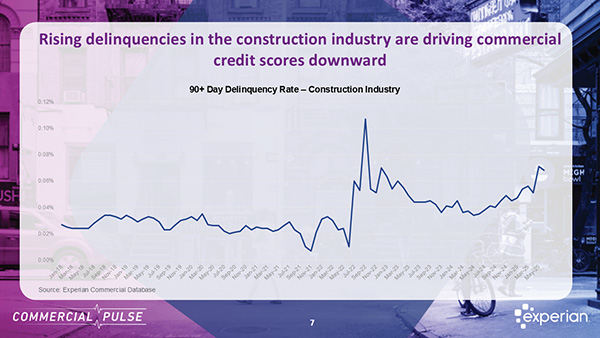
This week Experian focuses on the growing construction industry and early warning risk signals for lenders and risk managers.
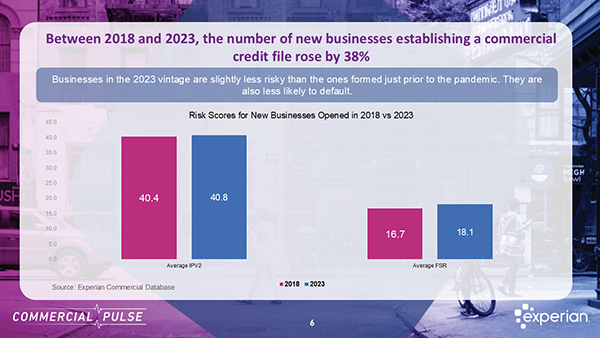
Discover how small businesses have transformed since the pandemic, from digital adoption to growth resilience, in Experian’s latest report.
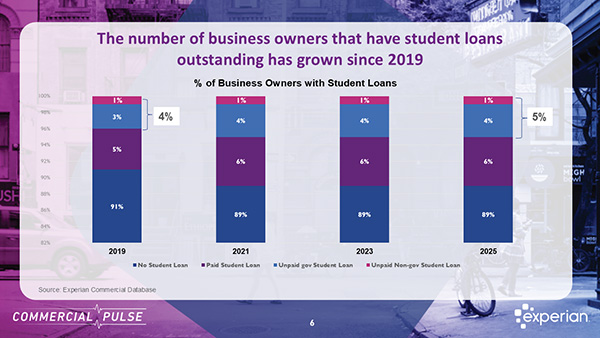
Experian Commercial Pulse Report - Business owners with unpaid student loans carry a higher risk for lenders.
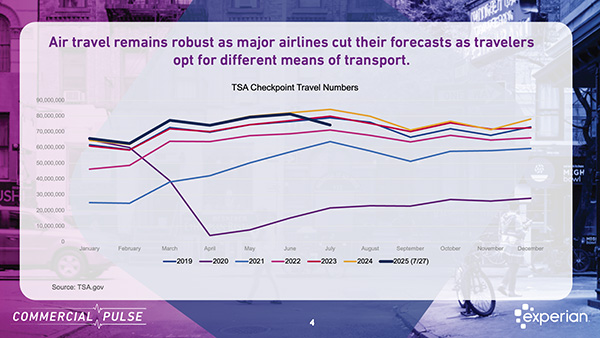
As temperatures rise across the U.S., so does the nation’s appetite for travel—and the Leisure & Hospitality sector is feeling the heat. In this week's Commercial Pulse Report, we examine how soaring consumer demand intersects with evolving credit conditions for businesses in travel, lodging, and transportation. Travel Rebounds, But the Story Is Mixed By every measure, Americans are traveling in droves. AAA projected over 72 million domestic travelers over the July 4th holiday—setting a record. Meanwhile, Memorial Day travel surged across all transportation types, especially road trips, which saw a 3.0% year-over-year increase. However, despite six new TSA checkpoint records in June, major airlines have cut forward-looking forecasts, signaling a notable shift: travelers are increasingly opting for alternatives like road and rail over the skies. This change in travel behavior has direct implications for how different business subsectors access and manage credit. Infrastructure Drives Commercial Credit Trends The Leisure & Hospitality industry is broad and fragmented—from mega-airlines and hotel chains to small sightseeing operators and independent RV campgrounds. This diversity is reflected in commercial credit data. Businesses with heavy infrastructure needs—like airlines and hotels—tend to carry higher loan and credit line balances. Airlines, in particular, average the highest number of commercial trades, a reflection of their large-scale operations and capital intensity. Hotels also hold sizeable credit, but with a twist. While revenues have rebounded beyond pre-pandemic levels, occupancy rates remain flat due to an increase in room supply from new construction. The hotel pipeline stood at 6,211 projects with over 722,000 rooms as of Q3 2024, signaling sustained investment even amid margin pressures. Rental Cars: High Volume, Higher Risk The rental car sector stands out—but not in a good way. Despite being a key enabler of domestic travel, these businesses exhibit the highest commercial credit risk across the industry. According to Experian’s Commercial Risk Classification, 32% of rental car companies are considered Medium-High to High Risk, compared to less than 10% in categories like air transport and sightseeing. The elevated risk may be due to a combination of factors: fleet acquisition costs, multi-location exposure, and operational disruptions during the pandemic. While credit trades in this segment remain high, inquiries have declined over recent years, possibly reflecting tightening lending standards or constrained demand for new credit. Encouraging Risk Trends—With Exceptions Across the broader Leisure & Hospitality industry, there’s been a decline in commercial credit risk since 2020. The share of businesses classified as Medium-High or High Risk dropped from 11.7% to 8.5% as of April 2025. Most firms now fall into the Medium Risk category—a sign of normalization in the sector. Delinquency rates remain low (under 1%), and the average Intelliscore Plus v2 score has remained stable across most subsectors. Still, credit conditions vary sharply by business type, underlining the importance of nuanced risk assessment in portfolio management. Smarter Credit Allocation Starts with Subsector-Level Insight The summer travel surge is a powerful reminder of the sector’s resilience—but not all players are experiencing the boom equally. For credit professionals and commercial lenders, the latest data from Experian suggests a growing divide: infrastructure-heavy firms are leaning into credit, while high-risk subsectors like rental cars may warrant closer scrutiny. Whether your clients are in air transport or roadside accommodations, understanding these credit trends will be key to navigating the second half of 2025. ✔ Visit our Commercial Insights Hub for in-depth reports and expert analysis. ✔ Subscribe to our YouTube channel for regular updates on small business trends. ✔ Connect with your Experian account team to explore how data-driven insights can help your business grow. Download the Commercial Pulse Report Visit Commercial Insights Hub Related Posts
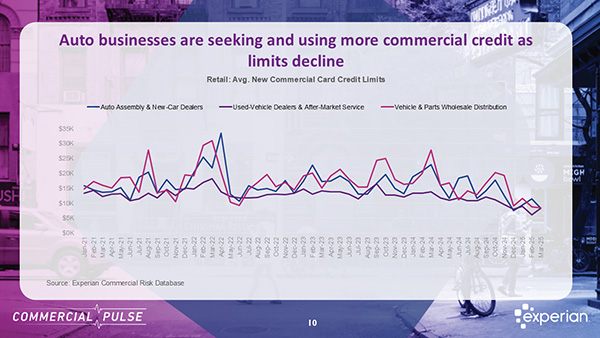
Experian's latest Commercial Pulse Report reveals rising car prices drive demand for used vehicles as commercial credit lines for b2b decline